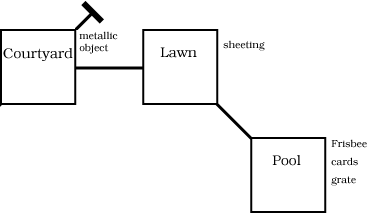Now back to the game. Notice how I didn't see the cards until I
looked at the grate? A lot of games "hide" items like that, which is
why I like to examine any items in a room which stand out. If I'm
stuck, often I'll go back through the rooms I've been in and make sure
I looked at everything. Let's grab those cards, since they might be
useful, and see if we can do anything with the grate.
>get cards and
x cards
With some difficulty, you fish the set of cards out of the outlet
grate. Taken.
It's a set of card-sized holographic images, in full colour, printed on some kind of synthetic backing material which has survived immersion in a pool of water for years. Flicking through the holos, you see images of an Ancient family seated in an aerial vehicle; a young girl, holding what looks like a fabric toy; the same girl, a little older, throwing an orange disklike object; the family again, together, around the pool; the girl, older yet, examining a blade of grass with an optical instrument. Definitely, this is an important xenohistorical artifact.
>i
You have a Frisbee Helipta and a set of holograms.
>open grate
The grate doesn't open; it's welded in place.
I've thrown a number of concepts at you in this last bit, so let me take them one at a time. You can stick several commands on the same line by putting AND, THEN, or periods between them. So GET CARDS AND X CARDS (or GET CARDS THEN X CARDS or GET CARDS. X CARDS) means "pick up the cards and then examine them." The cards themselves show pictures of times past. Notice that one of them show a girl throwing an orange disklike object? I bet that's a clue as to what to do with the Frisbee. Authors tend to put hints in descriptions like that, so read carefully when you examine things or enter a new room.
I then wanted to see what we were carrying, so I took inventory, which I abbreviated as I. That's the last of the abbreviations you'll use the most: I for INVENTORY, L for LOOK, and X for EXAMINE. We've got the frisbee and the holograms.
Then I tried opening the grate, in case it lead to somewhere. Since it's welded shut, I doubt we'll do anything else with it.
There's not much else to do here, since we can only go back to the northwest. (If you try to go in any other direction, like south, the game will tell you "You can only go up to the northwest.") Before we do, though, I need to introduce mapping. You don't have to draw a map, especially for a small game like this, but you might find it useful. When I'm mapping, I draw a square for each room and put the room's name in the middle of the square. I put little sticks off of each room showing the directions I can go, with north being towards the top. Beside each square I list the items I found there, or that I think are interesting. Doors or other obstacles are blocks.
Here's a cleaned-up version of the map I would have drawn so far for Glowgrass:

I think we can use that Frisbee to get the metallic object. Let's
see if I'm right.
>nw.w
Lawn
You're standing in a square area of neatly trimmed green lawn,
shimmering faintly in the afternoon light. To the west, the lawn
gives way to courtyard, and beyond it to the west and north are
buildings. An odd, paved rectangular depression in the ground leads
down to the southeast; the encroaching jungle vegetation further back
is kept at bay by a barrier of translucent sheeting.
Something about the scene gives you a sudden tingle of recognition, a surge of awe. As if you're walking into a legend.
Courtyard
This appears to be some kind of courtyard in the centre of an Ancient
dwelling. The building itself swings around to the north and west,
terminating in a crumbling retaining wall due south. A smaller domed
construction opens to the northeast, through a wide metal door
(closed). To the east is a flat space that could bear further
exploring.
You briefly catch a metallic glimmer from the top of the wall.
